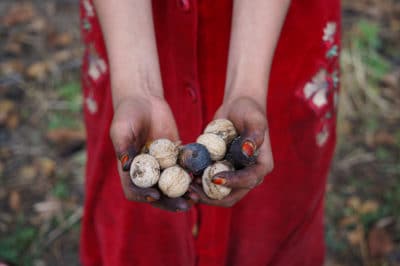The Dent Test
The best time to collect black walnuts is when their outer hulls are slightly soft and greenish-yellow. Pick a few up and squeeze them lightly between your thumb and forefinger. If their hulls dent, they’re ripe enough to harvest.
Things You’ll Need
- Heavy-duty rubber gloves to protect your hands from stains
- Old clothes and washable footwear
- A pole for shaking branches
- Protective headgear
- Sharp paring knife
- High-pressure garden hose
- Mesh screen for draining buckets
- Mesh bags (onion bags work well)
- Airtight containers
Harvesting the Walnuts
Because black-walnut hulls cause serious stains, harvesting is messy, messy work. Tackle the job in your oldest work clothes and shoes; always wear heavy-duty rubber gloves when handling the nuts.
Expert gardener’s tip: Harvesting black walnuts takes much more effort than harvesting English ones. When we say elbow grease, we mean it!
Collecting
Gather all the ripe fallen nuts from around the trees in buckets. If you want to harvest more, put on head protection and shake the branches with a long pole. If more drop, take only the ones that pass the dent test.
Hulling
To hull a black walnut, cut around its middle with a sharp paring knife (not so sharp that it pierces your gloves!) Then twist the two halves in opposite directions. They should separate easily, leaving the inner shell exposed.
Expert gardener’s tip: Never compost the hulls, because they’re loaded with juglones toxic to other plants. Bag them in paper bags and dispose of them as yard waste.
Washing
Fill a clean bucket halfway with hulled walnuts. Blast them with a high-pressure hose and discard floaters — air (and who-knows-what-else) has gotten inside their shells. Place a piece of mesh screen over the bucket and drain it where juglone traces won’t cause damage.
Drying
Hang the washed walnuts in mesh bags in a protected spot such as a garage. Dry them for four or five weeks, shaking the bags daily to expose all the nuts to air. Once dry, the in-shell nuts can be stored in airtight containers and frozen for up to a year.
